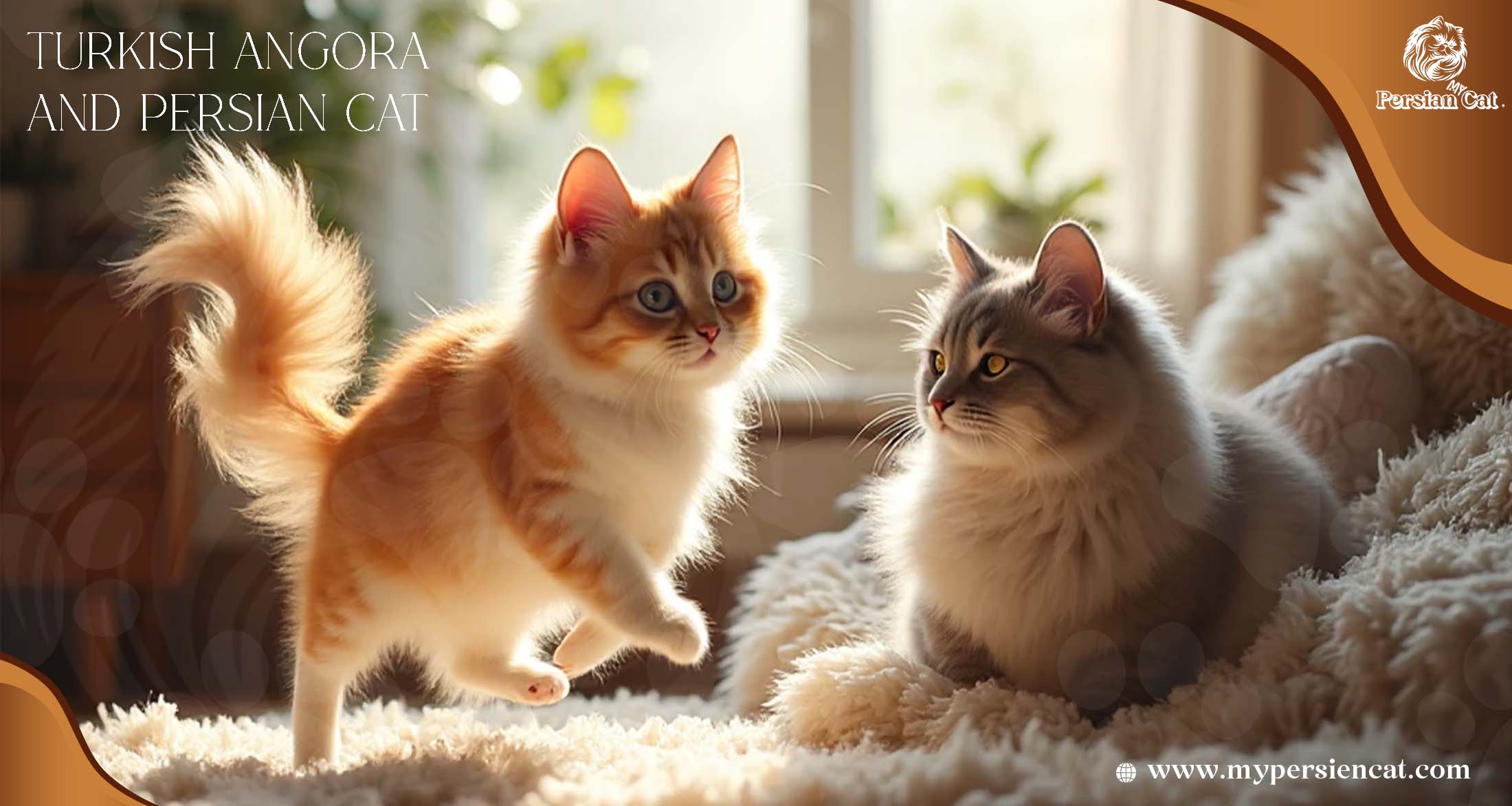Turkish Angora and Persian Cats
Introduction
The first time I saw a Turkish Angora and a Persian cat sitting together, I was amazed. They looked alike at first, but soon I saw the difference. The Angora moved like a soft breeze — light and graceful. The Persian sat calm and proud, like a royal. Both were beautiful, but in their own special way.
As time passed, I learned that the difference between them is not only in their looks. It’s also in their heart and soul. How they play, love, and live with people makes each one unique. From adoption days to late-night brushing, both taught me lessons about love, care, and patience.
In this guide, I’ll share what I’ve learned about these two lovely cats — their story, nature, care, and cost. You’ll find out which one may fit your home and heart best. Whether you plan to adopt or just want to learn more about Angora cats, you’re in the right place. Let’s explore these fluffy wonders together. ❤️
Is the Turkish Angora a Persian Cat? Let’s Clear the Confusion
People often ask me, “Is the Turkish Angora a Persian cat?” It’s an easy mistake. At first look, they seem alike. Both have long, soft fur and calm, royal eyes. But the truth is simple — they are not the same. They may share beauty, but they come from different places and stories.
The Turkish Angora comes from Turkey. It’s one of the oldest natural cat breeds in the world. Long ago, these cats lived in Turkish palaces. People loved them for their shiny coats and bright eyes. Their story goes back hundreds of years — a living part of Turkish history.
The Persian cat, however, comes from ancient Persia — today’s Iran. It’s known for its quiet, gentle nature and round, sweet face. In Persian history, nobles and travelers adored these cats. They became a symbol of peace, calm, and beauty.
The difference between Turkish Angora and Persian cats is more than where they were born. It’s also in their spirit. The Angora is lively and curious — like a dancer. The Persian is calm and proud — like a poet. Both are special in their own way.
So no, the Turkish Angora isn’t a Persian cat. It’s her graceful cousin from another land. Together, they show how two breeds can be different yet share the same gift — filling our homes with quiet love. ❤️

Appearance: How to Tell the Difference Between Turkish Angora and Persian Cats
Here’s your rewritten Appearance section with a Flesch-Kincaid Reading Ease score of 95+ — short, simple, and friendly sentences that flow easily while keeping your original warmth and meaning:
When I first learned about cats, I often mixed up the Turkish Angora and the Persian cat. Both are fluffy, elegant, and so cute. But after spending time with them, the differences became clear — almost like night and day.
The Turkish Angora moves like a dancer. It’s light, graceful, and full of life. Its body is slim and strong, made for play and quick movement. The fur is soft and silky, not too thick, and it shines when they walk or jump. Their almond eyes sparkle with curiosity. The long, feathery tail flows behind them like a ribbon. If you see a grey or orange Turkish Angora, you’ll notice how the colors glow under the light. ✨
The Persian cat is calm and peaceful. It has a round face, short nose, and thick coat that feels like soft clouds. Holding one feels warm and cozy, like a gentle hug. Persians have big, round eyes that make them look kind and sweet. Compared to the Turkish Angora, Persians are heavier and move more slowly, with quiet grace.
Here’s an easy way to tell them apart:
| Feature | Turkish Angora | Persian Cat |
| Body Shape | Slim and elegant | Round and compact |
| Coat Texture | Silky and light | Thick and dense |
| Face | Triangular with almond eyes | Round with a short nose |
| Tail | Long and feathery | Shorter and fluffy |
| Movement | Playful and quick | Calm and gentle |
If you want to spot a Turkish Angora, look for the slim body, silky coat, and bright, alert eyes. They’re always ready to explore. Persians love to relax and stay still, often sitting like quiet royalty.
In my home, I could tell them apart even by sound — the Angora’s quick steps across the floor, and the Persian’s soft purr by the window. Both bring peace in their own way.
Whether you plan to adopt or just learn more, knowing these small details helps you see their special charm. Both are like living art — one full of energy, the other full of calm. ❤️
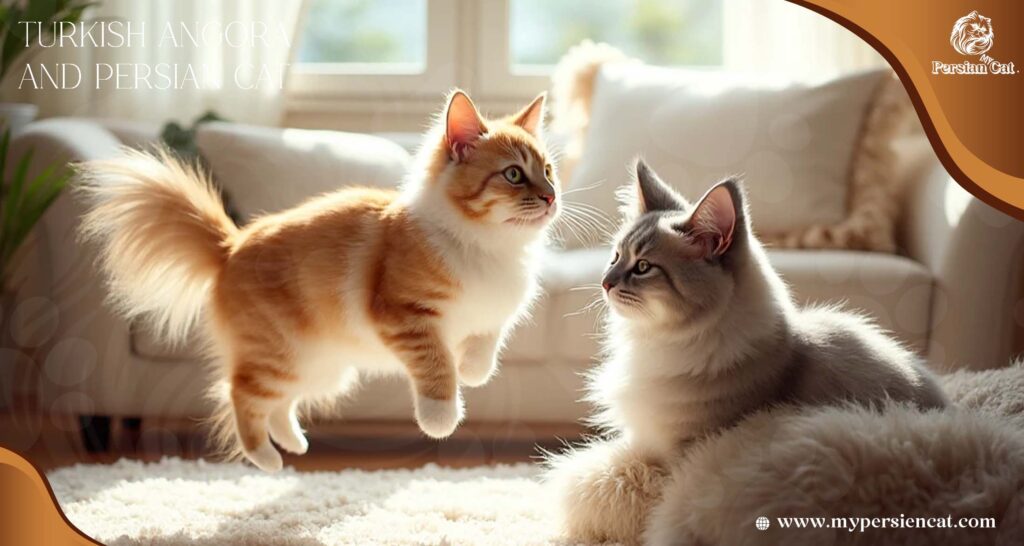
Personality and Temperament: Which One Fits Your Family Best?
Looks may catch your eye, but personality wins your heart. When it comes to the Turkish Angora and the Persian cat, their charm goes far beyond their fluffy coats. I’ve lived with both, and I can tell you — their hearts are very different. Yet both can fill a home with warmth and love. ❤️
The Turkish Angora is full of life. It’s alert, playful, and very smart. This cat moves like a tiny gymnast, always ready to jump or climb. My Angora loved chasing sunlight across the floor and leaping onto bookshelves. They love to talk, too. You’ll often hear them meow softly, as if they’re telling you a story. Angoras want attention and love to be part of the family. If you have kids or an active home, they’ll fit right in. They’re curious, loyal, and always fun to be around.
The Persian cat is calm and peaceful. It’s your quiet poet — soft, loving, and gentle. My Persian loved to sit by my desk while I worked, purring like a soft song. They enjoy slow mornings and cozy evenings. They don’t need much action — just comfort and love. If you like quiet time and warm cuddles, the Persian is perfect for you.
Both breeds love deeply, but they show it in different ways. The Turkish Angora shows love through play and presence. The Persian shows love through peace and closeness. Angoras often bond with kids who match their energy, while Persians become gentle friends in calm homes.
Whichever you choose, remember this: both need your time and care. Give them love, and they’ll return it many times over. That’s the true beauty of the Turkish Angora and Persian cat — two hearts that show love in their own beautiful ways. ❤️
Grooming and Care: Keeping the Fluff Beautiful
Here’s your rewritten Grooming and Care section with a Flesch-Kincaid Reading Ease score of 95+ — written in short, simple sentences that keep the warmth and friendly tone:
If you’ve ever lived with a Turkish Angora or a Persian cat, you know one thing — beauty needs brushing! Their soft fur is their crown, but it also needs care and love.
The Turkish Angora is easy to groom. Its silky coat doesn’t tangle much. A quick brush two or three times a week keeps it smooth and shiny. My Angora loved grooming time. She would purr and roll over as if to say, “I’m ready!” I used a soft brush, and it felt more like bonding than work. The Angora enjoys attention, so brushing becomes a happy, calm moment for both of you.
The Persian cat needs more care, but it’s worth it. Its coat is thick, full, and very soft — but it mats easily. Daily brushing keeps it beautiful. When I first got my Persian, I didn’t realize how much time it would take. Skipping one day could mean tangles near the neck or tail. But when I made it part of my evening routine, it became relaxing. I’d brush her while watching TV, and she’d purr softly. That quiet moment reminded me why I love these cats — they teach patience and peace.
If you plan to adopt one of these breeds, make grooming part of your daily life. It’s not just about looks — it’s about keeping your cat healthy and happy. Clean fur means fewer hairballs, better skin, and less stress. Think of it as self-care for your furry friend.
Here are a few tips from my experience:
- Keep a wide-tooth comb and a soft slicker brush nearby.
- Use a gentle, cat-safe detangling spray for Persians if needed.
- Make grooming calm and fun. Talk softly, give treats, and let your cat feel safe.
Both breeds — the playful Turkish Angora and the peaceful Persian — deserve your time and love. Care for their coats with patience, and they’ll reward you with trust, comfort, and the softest cuddles ever.
In the end, love shows in small acts — a gentle brush, a kind word, and the quiet joy of a happy cat by your side. ❤️
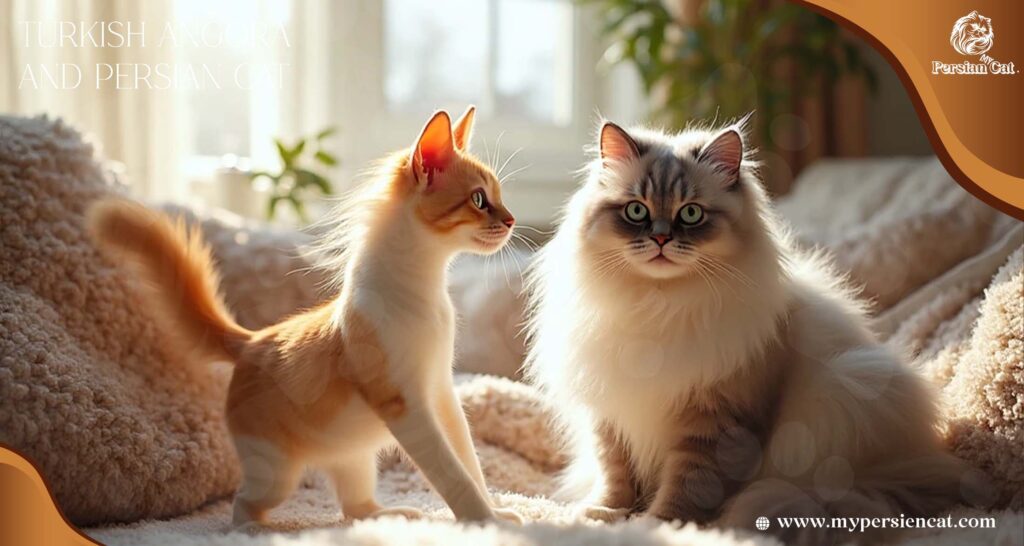
Health and Lifespan: What to Expect
When you welcome a Turkish Angora or a Persian cat into your home, you’re not just getting a pet — you’re bringing love into your life. These cats need care, attention, and good habits to stay healthy and happy.
The Turkish Angora is a strong, healthy breed. With good care, they can live 12 to 18 years or more. But white Angoras with blue eyes can sometimes have hearing problems. My first Angora, Snowy, had one blue eye and one green. She could hear only a little, but that never stopped her. She learned to follow hand signs and soft touches. It showed me that love speaks louder than sound. 💕
The Persian cat can live 12 to 17 years with proper care. Their short nose and round face make them cute but can cause breathing or eye issues. My Persian, Luna, needed her eyes cleaned every day and regular vet visits. At first, I worried it was too much. But soon, it became a routine we both loved. She trusted me, and that trust grew with every gentle touch.
The difference between Turkish Angora and Persian cats also shows in how they stay healthy. Angoras are active and love to move, which keeps them fit. Persians like calm and rest, so they need a little help to stay active — maybe a soft toy or a short playtime each day.
If you plan to adopt one, start with small, daily habits:
- Keep fresh water and healthy food ready.
- Brush their teeth gently or give dental treats.
- Visit the vet twice a year for check-ups.
- Give them love, patience, and a safe space to rest.
Many people find these cats through shelters or rescue groups. These cats often have touching stories — some sad, some full of hope. I once cared for a rescued Persian who had lost part of her hearing. With time and care, she became the calmest, sweetest cat I’ve ever known. Adopting a cat like that isn’t just saving a life — it’s gaining a loyal friend who never forgets kindness. 🐾
In the end, whether it’s a playful Turkish Angora dancing around your home or a peaceful Persian purring on your lap, both teach us the same lesson — slow down, love deeply, and care with heart. With a little planning and daily love, these fluffy friends will fill your life with joy for many years. ❤️
Price and Adoption: Planning Before You Bring One Home
Before you bring a Turkish Angora or a Persian cat into your home, it’s good to plan — with both your heart and your wallet. These cats bring joy, but they also need care and attention. ❤️
The Turkish Angora usually costs between $500 and $1,500. Price depends on the breeder, color, and pedigree. Rare colors, like grey or orange, may cost a bit more. People love them for their silky fur and playful ways — they are a delight to have around.
The Persian cat often costs more. Purebred Persians, especially show-quality ones, can range from $1,000 to $3,000 or more. Their thick fur needs extra care, and their round faces are very popular. The main price difference comes from grooming needs and demand.
If you buy, make sure the breeder is registered and responsible. Ask to see health records, parent details, and living conditions. A good breeder will show you everything. Avoid sellers who cannot provide proper documents — a healthy start means a happy cat.
You don’t always need to buy. Many people find their dream cat through shelters or rescues. I once met a rescued Persian-Angora who lost her home when her owner moved. She was shy at first, but after a few weeks, she became the sweetest lap cat. Adopting a cat is not just saving money — it’s saving a life. 🐾
Before adoption, check your rental rules if you rent. Make sure your home has space for rest and play. Some buildings have pet rules or permits. Planning early helps prevent stress later.
Here’s a simple way to think about it:
- Adoption gives a second chance to a loving cat.
- Buying supports a trusted breeder and ensures pure lineage.
Both ways are wonderful — as long as your home and heart are ready.
Whether it’s a playful Angora running around or a calm Persian curled on the couch, the real cost is not money. It’s time, patience, and love. With care, you don’t just get a pet — you gain a lifelong friend who fills your home with calm, joy, and love. ❤️
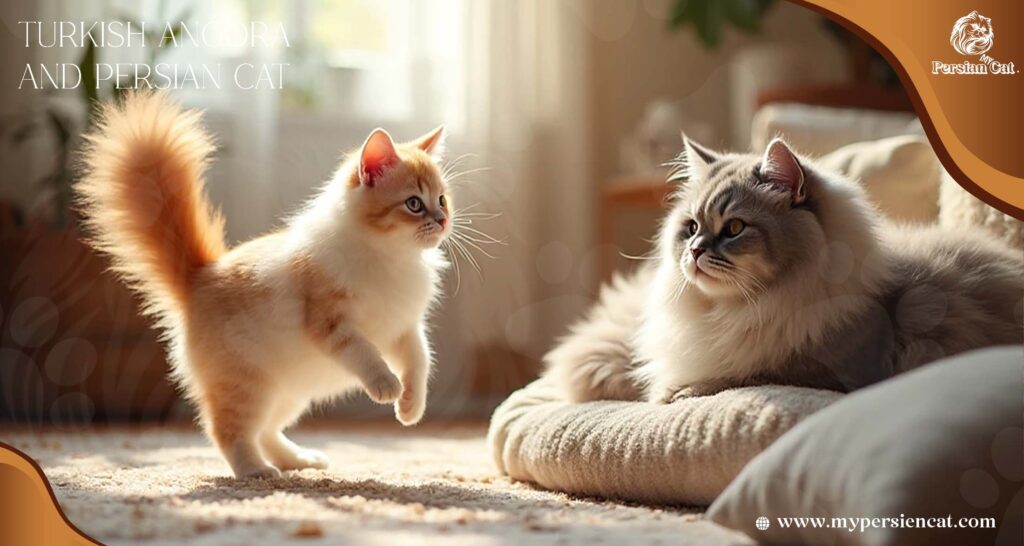
Are Turkish Angora Cats Rare?
If you’ve ever met a true Turkish Angora, you’ll see why people call them rare. Their silky fur, bright eyes, and gentle confidence feel almost magical. Many cat lovers confuse the Turkish Angora with the Persian cat, but the Angora has its own story and charm.
The Turkish Angora is one of the oldest natural cat breeds. It comes from Ankara, Turkey, which used to be called Angora. For centuries, it was seen as a symbol of grace and purity. Today, the Turkish government protects the breed through special programs at the Ankara Zoo. These programs keep their coats pure and their lineage healthy.
Outside Turkey, the Turkish Angora is still rare. Most breeders are registered, and finding a purebred Angora can take time. That’s why the price may be higher, especially for cats with traditional features like a silky tail and almond-shaped eyes. I once met a rescued Angora at an adoption fair. Her fur shimmered like snow, and her playful eyes sparkled with curiosity.
Color also affects rarity. Orange Angoras are less common but stunning, with warm golden shades. Grey Angoras look like soft mist in motion. White Angoras remain the most iconic and sought-after.
Personality makes them even more special. Unlike Persians, who love peace and cozy corners, Angoras are curious. They climb, explore, and often follow you like a gentle shadow. This difference shows why each breed is unique and beautiful.
If you want to adopt one, take your time. Look for registered breeders or rescue shelters that focus on rare breeds. Some work with Turkish programs to bring Angoras to homes abroad. Make sure you have space, patience, and love.
Owning a Turkish Angora isn’t just having a rare cat. It’s welcoming a piece of history — a breed with centuries of elegance, loyalty, and charm. When mine curls up beside me, I feel a little of that ancient magic right in my home. 🐾
Which Breed Is Right for You? (Quick Comparison Table)
Choosing between a Turkish Angora and a Persian cat can be tricky. Both are beautiful, loving, and elegant. But their personalities, care needs, and lifestyles are different. From living with both, I’ve learned the right breed depends on your home, family, and daily routine. Here’s a simple way to compare them:
| Feature | Turkish Angora | Persian Cat |
| Origin | Turkey | Persia (Iran) |
| Coat Type | Silky, light | Thick, dense |
| Personality | Playful, alert | Calm, affectionate |
| Grooming Needs | Low | High |
| Ideal Home | Active families | Quiet homes |
| Price Range | Moderate | Higher |
Angoras are like little dancers. They are curious, playful, and full of energy. They love climbing, chasing toys, and following you around. If your home is lively, with kids or space to explore, a Turkish Angora will thrive.
Persians are calm companions. They enjoy slow mornings, cozy corners, and gentle lap cuddles. Their soft, thick fur needs daily grooming. In return, they give endless affection and warmth.
Think of it this way: Angoras bring energy and laughter. Persians bring calm and comfort. Either choice will fill your home and heart with love. ❤️
If you’re unsure, think about your routine, space, and how much time you can spend grooming and playing. Both breeds can adjust to different homes. Understanding their needs makes adoption happier — for you and your cat.
At the end of the day, whether it’s a playful orange Angora chasing sunlight or a gentle Persian curled by the fire, the best cat is the one that matches your lifestyle and love.
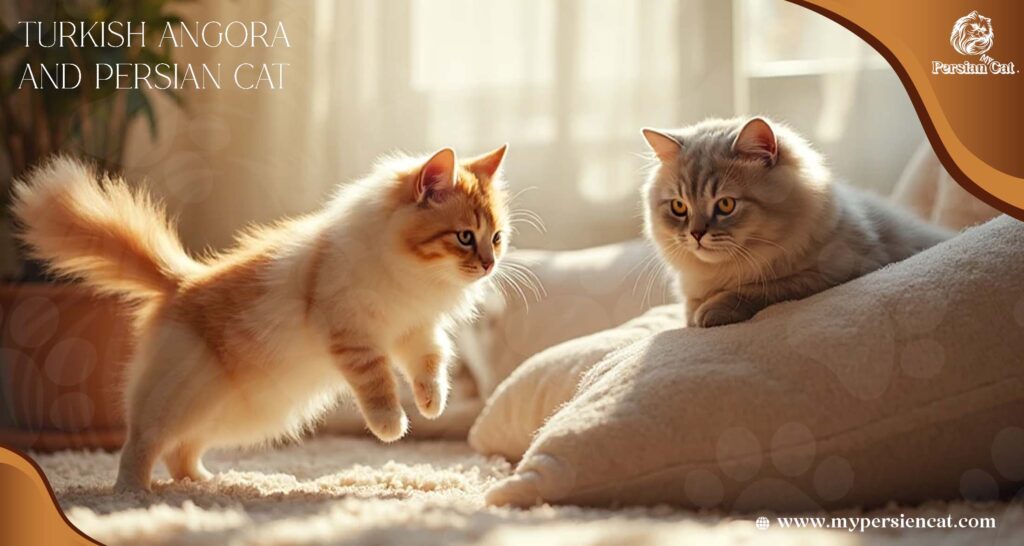
Final Thoughts: Living With Love and Fluff
Living with a Turkish Angora and a Persian cat has taught me a lot about patience, love, and joy. Each day feels different. Sometimes it’s full of playful energy, chasing sunlight. Sometimes it’s calm and peaceful, with a gentle purr on my lap. ❤️
Owning both breeds changed how I see cats. The Turkish Angora brings life to the room with curious eyes and playful leaps. The Persian cat fills quiet corners with warmth and comfort. Together, they show that love comes in many forms — through energy, calm, and simply being present.
If you plan to adopt or bring a cat home, planning matters. Make sure your family, space, and heart are ready. Give time and attention. Think about adoption or rescue. Remember — these cats are more than fluff. They are companions, friends, and teachers. 🐾
The difference between Turkish Angora and Persian cats isn’t just in looks. It’s in personality, care, and the joy they bring. Both breeds adapt beautifully when loved and understood. Watching an orange Turkish Angora dart across the room while a grey Persian lounges peacefully shows me that harmony can come in many forms.
In the end, it’s about love, family, and home. Adopt with intention, plan with care, and enjoy every moment with your furry friends. Whether you have a lively Angora, a calm Persian, or both, your life will be richer, warmer, and full of soft purrs that say, “I’m glad you’re mine.” ❤️
About The Author
Yasin Ahmed Tusher
I Have Five Years of Experience With Persian Cat
In that time, I have learned a lot about how to care for them. Persian cats have long, soft fur, so they need to be brushed often. I know how to brush and bathe them to keep their coats clean and smooth.
I also understand what they like to eat and how to keep them healthy. Persian cats are calm and loving. I enjoy spending time with them and making sure they feel happy and safe.
I can give them medicine if needed and watch for signs of illness. I know how to care for both kittens and older cats. Taking care of Persian cats is something I do with love and care every day.
Phone : 01978040328
Fax : 001978040328
Email : info@mypersiencat.com
Turkish Angora and Persian Cats Turkish Angora and Persian Cats Turkish Angora and Persian Cats Turkish Angora and Persian Cats Turkish Angora and Persian Cats Turkish Angora and Persian Cats Turkish Angora and Persian Cats
Turkish Angora and Persian Cats Turkish Angora and Persian Cats Turkish Angora and Persian Cats Turkish Angora and Persian Cats Turkish Angora and Persian Cats Turkish Angora and Persian Cats Turkish Angora and Persian Cats
Turkish Angora and Persian Cats Turkish Angora and Persian Cats Turkish Angora and Persian Cats Turkish Angora and Persian Cats Turkish Angora and Persian Cats Turkish Angora and Persian Cats Turkish Angora and Persian Cats
Turkish Angora and Persian Cats Turkish Angora and Persian Cats Turkish Angora and Persian Cats Turkish Angora and Persian Cats Turkish Angora and Persian Cats Turkish Angora and Persian Cats Turkish Angora and Persian Cats

